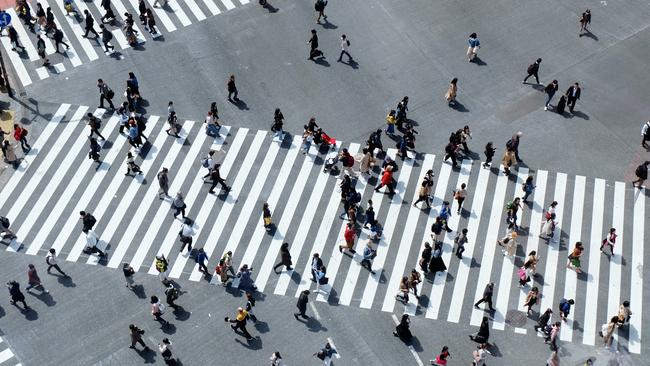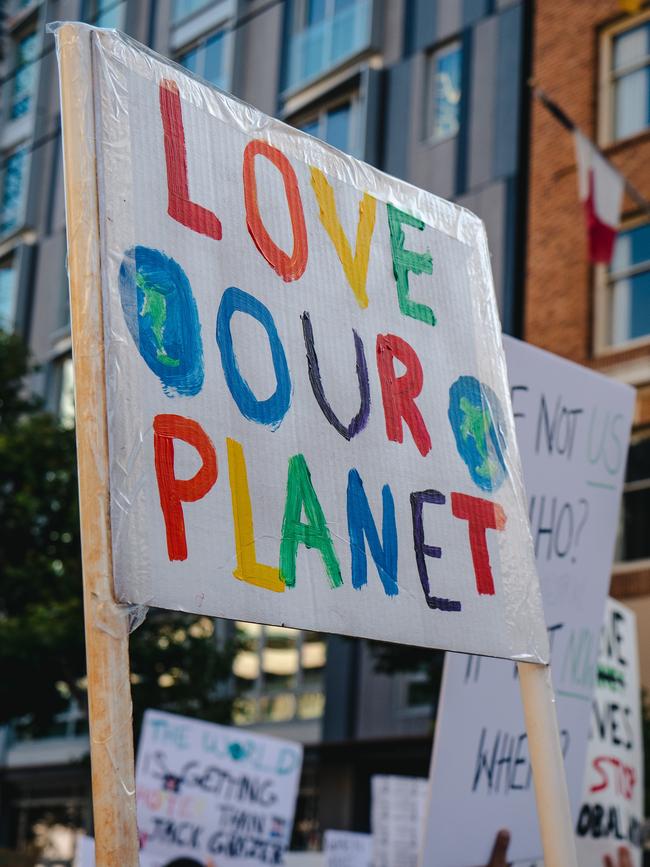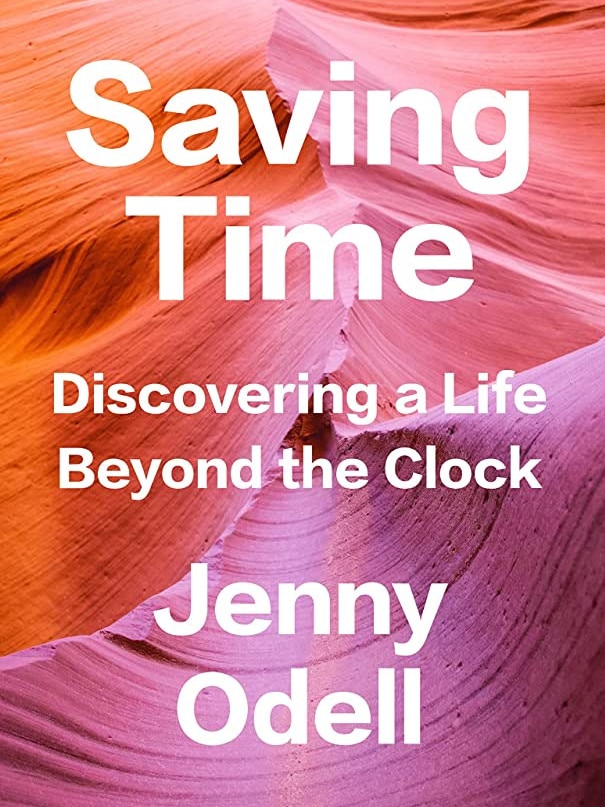The cure to life without time anxiety lies with collective change
Global warming, productivity and even our own mortality … anxieties around time are at an all-time high. But individual hacks aren’t the answer.

It is while experiencing reasonably high levels of time anxiety that I sit down to write this story … about time anxiety. The Intergovernmental Panel on Climate Change (IPCC) recently released a report claiming the next 10 years are critical in slowing down the progress of global warming, or else catastrophic weather events risk becoming too extreme for humanity to handle. “There is a rapidly closing window of opportunity to secure a liveable and sustainable future for all,” states the AR6 Synthesis Report.
As the existential terror of these findings bubbles away in the back of my mind, my prefrontal cortex hums with thoughts of competing work priorities, text messages I haven’t replied to and this irrational sense of guilt I’m harbouring for choosing to stay out late with friends on Saturday night, which consequently launched me into the work week feeling tired and frazzled. The irony of this situation – writing about time anxiety while feeling stressed about deadlines – isn’t lost on me. I decide to lean in.
According to the Cleveland Clinic, chronophobia – more commonly known as time anxiety – is “an extreme fear of time or the passage of time”. “People with this anxiety disorder feel intense discomfort or dread when they think about time passing them by,” states the research centre, adding that in severe cases, time anxiety “can lead to panic attacks, social isolation and problems with relationships”.
While I wouldn’t classify my own fear as extreme, I’ve certainly experienced the discomfort and dread that comes with feeling like you never have quite enough time.
In 2023, most stressors – whether immediate or more existential in nature – seem to relate to, or be intensified by, the passing of time. A 2021 survey by the Australian Bureau of Statistics (ABS) into the wellbeing and social experiences of Australians found that one third of Australians reported “always” or “often” feeling rushed for time.
Figures like this probably don’t elicit a sense of shock horror in you, either. After polling my friends, family and colleagues about how rushed they feel for time on any given day, and discovering the average answer is something along the lines of “pretty rushed”, I am surprised that statistic isn’t higher.
“Time is our most valuable non-renewable resource,” wrote the American-Hungarian-Romanian physicist Albert-László Barabási. “If we want to treat it with respect, we need to set priorities.”
If there’s one thing our productivity-obsessed culture is desperate for, it’s more hours in the day. We want to do more, multitask better, and find tactics to make time-consuming tasks less time-consuming, so we have more time to, well, optimise our time. But who exactly is this obsession benefitting? And – to get really existential – by compulsively searching for pockets of time during the day to accomplish more or whatever we deem immediately important, how many hours, days and years of that critical window of time are we losing to more pressing matters?
It’s this concern that provides the overarching framework to Jenny Odell’s new book, Saving Time (Bodley Head, $35). Since writing the manual on resisting the attention economy, the bestselling How to Do Nothing, in 2019, Odell, an American artist, writer and academic, has become something of a preeminent authority on how to exist within modern society without going completely mad.
In Saving Time, she examines how the Western world became governed by the belief that time is money, and how detrimental this is not only to our own physical and mental health, but also the health of the planet.
“Some of the early American researchers that were obsessed with the language of productivity were also really into eugenics, which is no real surprise,” says Odell. “They had this dream of a human machine, one that was just as efficient as the machines we were working on.”
Odell is in her native Oakland, California, a city in the Bay Area near San Francisco that is also a major port. She informs me the storm clouds, which have been cloaking the region for days, have lifted, and she’s looking forward to going for a walk.
Just as they were in How to Do Nothing, the ideas Odell encounters on her walks – and her time spent in nature, observing the rhythms of the environment more generally – are threaded throughout Saving Time. The link between time and global warming maintains a presence throughout the book and soon, our conversation meanders to the IPCC’s Synthesis Report – the one that states we have 10 years to write the wrongs of our colonial, industrial and now capitalist forefathers, or else hurtle towards planetary destruction.
Although in some contexts, a decade can feel like an eternity, in the face of climate change, I tell her, it feels like a terrifyingly short window.
“It can be difficult to take in something like that without feeling a sense of doom that can be paralysing,” she acknowledges. “I think conveying urgency is necessary, because it’s based on science. But also, the climate crisis is something that has been unfolding for a long time. That’s not necessarily a happy thought. But I find it useful to sort of, like … look around and recognise that this has been happening for a long time, in really uneven ways.
“Also, none of this had to happen. There have been windows of possibility throughout history in which we made wrong decisions, but that also means that conversely, in any moment, there are many avenues of possible action available to us.”

While Saving Time confronts some depressing truths, such as irreversible environmental decay that has occurred with the assistance of our burning of fossil fuels, Odell doesn’t want you to finish her book feeling worse about the state of things. Rather, Saving Time aims to recover and encourage a sense of agency over how we choose to use our time – and the possibilities contained in using that agency with others, as a collective.
“Agency is very deeply tied to how we think about time. If you see your life as operating on this linear timeline that is marching into oblivion, and every day is just filled with the same, undifferentiated stuff … I don’t think that particularly inspires agency,” she posits. “And of course, that’s very understandable for someone who is living on the clock and has little control over their own time. But I think there’s another view of time that is more dynamic, where actually, no moment is the same. If you have this view of time, it’s easier to imagine yourself doing something unexpected. Because it’s easier to imagine doing something new.”
Unless you’re self-employed, you don’t need to work to live or you’re fortunate to have an employer who values quality of work over the quantity of hours worked, you’re probably wondering how (and when) you’re supposed to tap into this “dynamic” time Odell speaks off. Despite what time-management books written by productivity gurus (Odell refers to them as “productivity bros”) may preach, very few of us enjoy complete control over our own time. And when we enter the workforce, not only are our employers buying our knowledge, strength and ability to work well in teams, they are also buying that most valuable nonrenewable resource: our time.
Like Odell, Professor Frederik Anseel, professor of management at the University of New South Wales Business School, traces the modern workplace’s obsession with efficiency back to the industrial revolution, where early “productivity bros” such as Henry Ford devised systems of work that improved industrial efficiency. “Jobs were broken down to modular pieces of work at the assembly line,” notes Anseel. “And while that enhanced productivity immensely, it was not necessarily good for wellbeing.”
–
“Let’s not reward people for the time spent on a task or job, but reward people for the results or contributions they achieve … giving people autonomy increases productivity”
–
Anseel is also the president of the European Association of Work and Organisational Psychology, and a great deal of his research revolves around mental health in the workplace. He acknowledges that “time pressure is an incredibly dangerous [stressor]” because of the way it can “prevent someone from seeking resources like support and help from others, or engaging in relaxing activities”, therefore “chronically undermining their recovery”.
“Normally, processes such as the psychological detachment from work during non-work time, physical exercise, and sleep have the potential to protect our wellbeing. And while the experience of time pressure calls for effective recovery processes like these, research shows that those processes become impaired when time pressure is high. Because when people are time poor, they develop tunnel vision,” explains Anseel.
While the synthesising of workflow may have helped speed things up in 18th-century factories, this style of organising work wasn’t designed to be applied to 21st-century knowledge based jobs. Yet I regularly hear my lawyer, tech and media industry friends lament how “under the pump” they feel in workplaces where time is money, and therefore, each minute of the day counts. In some cases, this is literal. In the legal field, the concept of billable hours – the hours worked by an employee for an employer that are measured and then billed to the employer’s client – mean that workers’ computers are often fitted with time-tracking apps.
Unsurprisingly, yet paradoxically, Anseel says the surveillance element of devices like this can result in increased feelings of anxiety. “They put a price on every hour (or minute) of someone’s working life, which creates additional stress. Every minute spent being unproductive creates the stress that it is costing them money.”
As for why we’ve inherited such an archaic form of standardised time measurement, Anseel suggests it could boil down to “the spirit of tradition”. “We probably need to step away from this and think more about outputs, results and contributions. Let’s not reward people for the time spent on a task or job, but reward people for the results or contributions they achieve. We also know that giving people autonomy and flexibility increases productivity. If you build autonomy, self-control and flexibility in job design, people will not only feel less stressed, they will also be more productive.”
Of course, external factors like deadlines, family commitments and unexpected events, like a sick pet or child, can throw our predetermined schedules out the window – a friend once referred to spontaneous work meetings as “hijacking” his days. But time anxiety can also come from within.
A common example of self-inflicted time anxiety is motivated by our fear of the most human function: the biological clock. This particular form of anxiety is most widespread among women – the aforementioned ABS study discovered that more females (35 per cent) reported “always” or “often” feeling rushed for time, while only 30 per cent of males did. Females aged 25 to 39 years were also more likely than their male counterparts to report feeling rushed for time (47 per cent compared to 38 per cent). When you consider it is during these years that a woman’s natural fertility is highest, it’s no wonder the decision of whether or not to have a family, and how to balance that with a career, financial demands and social commitments, is linked to feeling more pressured for time.
Perinatal psychologist Genevieve Anderson witnesses time anxiety on a daily basis, from women at the preconception stage, during pregnancy and the postpartum period. But it doesn’t end there. “Time anxiety also manifests as worry about developmental milestones for the newborn. Parents might worry about their baby meeting these milestones, or feel anxious about whether they are doing enough to support their development.”
More recently, developments in IVF have given women greater control over when they are able to conceive. Anderson acknowledges the myriad positives of these developments, such as reducing the stigma around those experiencing infertility, as well as those deciding to have children later in life. Workplaces are also keenly aware of these positives, and increasingly, companies from Spotify to Pinterest are adding egg freezing to their list of workplace benefits.
Ostensibly, policies like these are promoted as giving female employees greater flexibility and control over their reproductive choices. “However, this can also create a cultural expectation that workers will prioritise their careers over their personal lives. It’s worth noting that egg freezing does not guarantee a pregnancy,” cautions Anderson. Interestingly, a 2023 study titled “Progressive or Pressuring?” that appears in the Journal of Applied Psychology found that “although egg freezing coverage is intended to support employees’s personal lives … egg freezing policies were found to send a stronger signal that personal-life sacrifice is encouraged.”

A fear of mortality is another manifestation of time anxiety. In Saving Time, Odell explores this in a chapter titled Life Extension. “It’s supposed to sound like you’re going to try to make more of your life, or make your life longer. But as you read through the chapter, I’m trying to articulate the idea that you could feel more alive in any particular moment simply by being more attentive to the other forms of life around you,” she says. “I think there’s this very modern feeling, and it’s encouraged by our culture of consumerism, that as a human individual, you exist in a world that is kind of inert. Like, it’s alive, but it doesn’t really seem like it has its own agency, or its own timeline. To me, that’s very deadening.”
Odell says that by simply paying attention to something that’s growing and reacting in time – such as the clump of moss that burgeons on her windowsill at the beginning of the pandemic – can be a reminder that not all life adheres to a linear, standardised format of time. “Everything is just affecting everything else all the time. Like a nesting colony. The way that birds will come back in accordance with the seasons, and use it in unexpected ways. The world is sort of alive to itself.”
The day this story is due, I take the afternoon off. It means I’ll hand it in a day late, which isn’t ideal. But my mind needs a break – it needs time and space to de-frazzle. Plus, rushing the process in order to force these ideas through seemed like doing the topic itself a disservice. So I switched on my out-of-office, left my phone at home and took myself on a walk. Unaware of how many minutes were passing, time felt more elastic than it had in weeks, maybe even months. I sat down by the beach and watched a crab scuttle across a rock before dropping into a crevice – in a couple of hours, the tide will rise again, just as it had fallen this morning, and after experiencing a few hours on land, that crab will become part of the underwater ecosystem once more.
“I am hopeful,” says Odell before we exchange our goodbyes. “I think so much agency comes through conversation. People have come together in the past to articulate different versions of how we can value time, and it really just started with initiative. It always starts with talking.”
Contrary to popular belief, a bleak future, she adds, is not predetermined. But in order to experience life with less time anxiety – whether it pertains to climate doom, work and productivity or the biological clock – individual hacks are not the answer, Odell concludes.
Being in sync with the world around us, and inviting others to come together to make cultural, social and maybe even political steps forward, is more likely to conjure positive change. “It’s what can we do, instead of what can I do.”
This article appears in the May issue of Vogue Australia, on sale now.


To join the conversation, please log in. Don't have an account? Register
Join the conversation, you are commenting as Logout